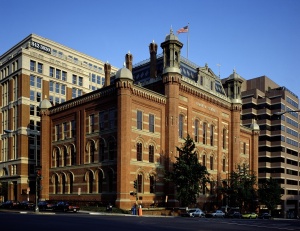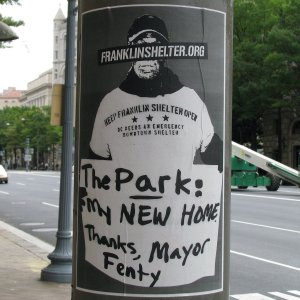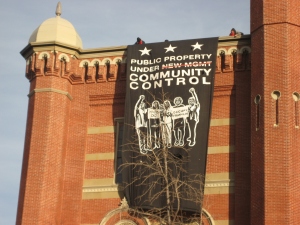
In 2008, Mayor Adrian Fenty closed the Franklin School shelter. While the history of the Franklin School shelter and the struggles over it are not as dramatic as the history of the Federal City Shelter, in many ways its story has significant parallels. The shelter came into being as a radical group of activists from MaydayDC took over the centrally located historic building in 2002. Its closure serves as a compelling case study for those thinking about the future of the CCNV shelter.
Franklin School, sitting at the corner of K Street and 13th Street NW has a long history and this history has become intertwined with contemporary struggles. The building constructed in 1869 at 13th and K St NW in Ward 2 was one of the nation’s first high schools, known for schooling presidents’ children and being the site of Alexander Graham Bell’s first use of the telephone. Preservationists have organized to prevent its demolition since the mid-1950s. In 1972 protestors formed the group Don’t Tear it Down to prevent the city’s potential sale of the building. In 1973 they successfully added the building to the National Registry of Historic Places. In 1978 the city itself passed one of the strictest historic preservation ordinances and Don’t Tear it Down transitioned to become the official DC Preservation League. In 1996, after sitting vacant for many years, the building became a National Historic Landmark.[1]
By the early 2000s, the city reconsidered proposals to sell the building to developers. The plans, however, met with staunch opposition from community activists concerned about the privatization of public property. In 2002, the group MaydayDC organized the 150 homeless residents in the neighboring Franklin Square Park to take over the school in August 2002. They argued the abandoned public property should be used as a homeless shelter given the large numbers of people sleeping on the downtown streets. After a series of arrests and five months later, the city agreed to operate the building as a temporary shelter.[2]
Prioritizing a particular version of the past, one that ignored the long history of the building and its surrounding neighborhoods, the DC Preservation League argued against letting the homeless occupy the building. In 2005, they backed a proposal to close the shelter and turn the building into a boutique hotel. Preservation became wedded to the business elites’ vision to commercially redevelop downtown. Mayor Anthony Williams proposal to lease the property to developer Herb Miller led to the brief closure of the shelter. In response, the residents and their supporters formed the Committee to Save Franklin Shelter and reoccupied the building, reiterating the dire need for homeless housing. As a result of growing community opposition and opposition on City Council, the redevelopment proposal collapsed and the building reopened as a shelter. At its peak it housed 300 men.[3]

A former member of the Committee to Save Franklin Shelter, Eric Sheptock, discusses the formation of the group…
sheptock_committeetosavefranklin
and the failure of the Williams’ proposal.[4]
sheptock_franklin_mayorwilliams
Efforts to close the shelter, spearheaded by area councilman Jack Evans, continued in the Adrian Fenty mayoral administration.[5] While efforts to find a developer continued, Fenty planned to close the shelter even before a development plan was put in place. He argued that he was doing so “to provide permanent supportive housing for our homeless neighbors, instead of placing them in a poor shelter environment.”[6]
From the perspective of many of the residents such as Sheptock, the promises of the Fenty administration rang hollow.[7]
While it is unclear how many, several of the residents did move into apartments in Northeast and Southeast Washington — far from the Franklin School Shelter. Others were told they would be taken across the river to a shelter on the campus of St. Elizabeth’s Hospital in Anacostia, a location many argued was inaccessible to their work and the social services they used. Other men promised to remain downtown and sleep on the streets.[8] The numbers of DC residents needing emergency shelter has only continued to grow.

While the promise of permanent housing is understandably alluring, Sheptock argues that as long as the housing remains unaffordable and jobs do not pay living wages, people will continue to be put on the street and in need of emergency shelter.[9]
Since its closure, the building has remained vacant while both the Fenty and Mayor Vicent Gray administrations have been unsuccessful finding developers to take on the project. In November 2011, protesters associated with the Occupy D.C. Movement took over the building displaying banners reading “Public Property Under Community Control” and “Franklin for the 99 percent.” Thirteen protesters were arrested. While the protest did not change the status of the building, it brought Franklin School back into the forefront for the conversation of homelessness.[10]
[1] Kathryn Wells, “Selling Shelters: Public Property Gentrification in Washington, D.C.,” MA thesis, Syracuse University, May 2008, p. 82-85.
[2] Wells, 86.
[3] Wells, p. 111-12; Washington Post, September 26, 2008.
[4] Sheptock, Eric. Interview by Alison Kootstra. Digital Recording. Washington, D.C., October 12, 2012.
[5] Lydia DePillis, “City Urged Not to Offload Franklin School,” Washington City Paper, November 19, 2010.
[6] Washington Post, September 27, 2008.
[7] Sheptock, Eric. Interview by Alison Kootstra. Digital Recording. Washington, D.C., October 12, 2012.
[8] Washington Post, September 26, 2008.
[9] Sheptock, Eric. Interview by StacieNicole Simmons. Digital Recording. Washington, D.C., October 12, 2012.
[10] The Examiner, November 20, 2011.